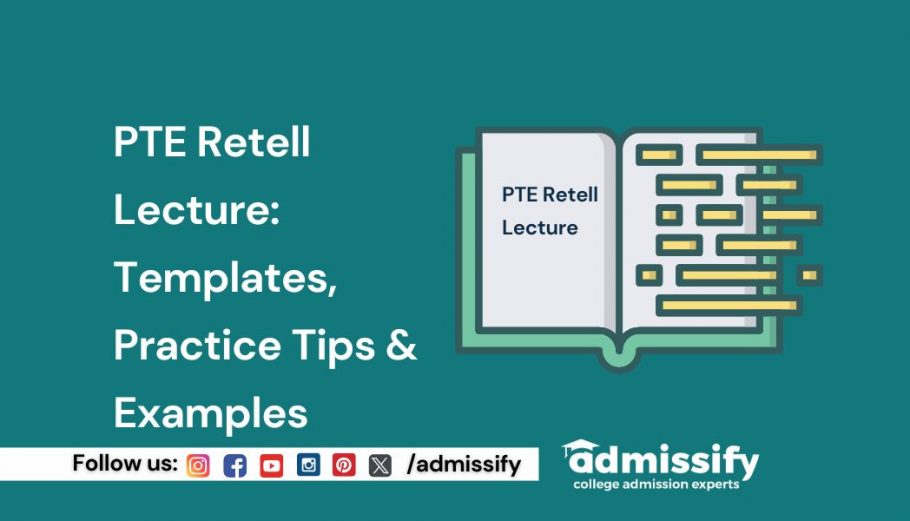Last Updated on October 22, 2024
The PTE (Pearson Test of English) Academic exam is a crucial step for many individuals aiming to study or work abroad. One of its key components is the PTE Retell Lecture task, which assesses both listening and speaking skills. This blog will delve into effective templates, practice tips, scoring criteria, and examples to help you excel in the PTE Retell Lecture section.
What is the PTE Retell Lecture?
The PTE Retell Lecture task requires candidates to listen to a lecture lasting up to 90 seconds and then summarize it in their own words within 40 seconds. This task evaluates your ability to comprehend spoken English and articulate your thoughts clearly and concisely.
Format of the PTE Retell Lecture
Understanding the format of the PTE Retell Lecture is vital for success. Here’s a detailed overview:
- Duration: The lecture lasts between 60 to 90 seconds.
- Response Time: After listening, you have 10 seconds to prepare your response and 40 seconds to speak.
- Recording: Your response is recorded, and you cannot pause or edit it once you start speaking.
Key Features of the Task
- Lecture Content: The lectures cover various academic topics, often including graphs, charts, or images.
- Variety of Accents: You may encounter speakers with different English accents (American, British, Australian, etc.), so familiarize yourself with diverse pronunciations.
- Types of Lectures: Lectures can be informative, persuasive, or descriptive. Understanding the type will help you frame your retelling.
Scoring Criteria for PTE Retell Lecture
The PTE Retell Lecture is scored based on several criteria:
| Criteria | Description |
| Content | Relevance and accuracy of the information conveyed from the lecture. |
| Form | Structure of your response, including clarity and coherence. |
| Pronunciation | Clarity of speech and correct pronunciation of words. |
| Fluency | Smoothness of speech without unnecessary pauses or hesitations. |
| Grammar | Correct use of grammar in your sentences. |
| Vocabulary | Appropriate use of vocabulary relevant to the topic discussed in the lecture. |
Each criterion contributes to your overall score, making it essential to focus on all aspects during preparation.
Structure of the PTE Retell Lecture
A well-structured response can significantly enhance your performance in the PTE Retell Lecture task. Here’s a recommended template:
| Section | Duration | Content |
| Introduction | 2-3 seconds | Briefly introduce the main topic of the lecture. |
| Main Points | 30-35 seconds | Summarize the key ideas and details presented in the lecture. Use notes for guidance. |
| Example | 2-3 seconds | Mention any illustrative example provided in the lecture. |
| Conclusion | 1-2 seconds | Reiterate the main theme or significance of the lecture content. |
Detailed Breakdown of Each Section
1. Introduction
Start with a clear statement that sets the context for your summary:
- “The lecture discussed the impact of climate change on marine ecosystems.”
This introduction should provide a concise overview of what the audience can expect from your summary.
2. Main Points
In this section, outline the main ideas presented in the lecture:
- “Firstly, the lecturer emphasized rising sea temperatures affecting coral reefs, leading to widespread bleaching.”
- “Secondly, he discussed threats to fish species due to shifting ocean currents affecting breeding patterns.”
- “Furthermore, ocean acidification’s consequences on shellfish populations were highlighted.”
Using transition phrases like “Firstly,” “In addition,” and “Lastly” helps create a logical flow in your summary.
3. Example
If applicable, briefly mention an example that reinforces your summary:
- “He illustrated ocean acidification with a case study on oyster farms in the Pacific Northwest.”
4. Conclusion
Wrap up your response by summarizing the key takeaway from the lecture:
- “Overall, global cooperation is crucial in addressing these pressing environmental issues.”
Practice Tips for PTE Retell Lecture
To excel in the PTE Retell Lecture, consider these practice tips:

- Active Listening
- Focus on understanding not just individual words but also overall concepts.
- Pay attention to tone and emphasis as they can indicate important points.
- Effective Note-Taking
- Use abbreviations and symbols to jot down key points quickly.
- Organize notes in a way that highlights main ideas and supporting details.
- Familiarize with Common Topics
- Review past PTE lectures or related materials to get accustomed to common themes.
- Practice summarizing lectures on diverse subjects.
- Utilize Templates
- Memorize various templates to structure your responses effectively.
- Customize templates based on personal preferences while maintaining clarity.
- Practice Speaking
- Record yourself retelling lectures to improve fluency and coherence.
- Seek feedback from peers or instructors on your delivery style.
- Engage with Authentic Material
- Listen to TED Talks or academic podcasts that mimic lecture formats.
- Try summarizing these talks as practice for your PTE Retell Lecture responses.
- Time Management Practice
- Use a timer during practice sessions to simulate real test conditions.
- Aim to complete each section within its designated time frame.
Example Responses for PTE Retell Lecture
Here are sample responses using different topics to illustrate how you can apply the template effectively.
Example 1: The Impact of Artificial Intelligence on Employment
Introduction:
“The lecture focused on how artificial intelligence (AI) is transforming job markets.”
Main Points:
“Firstly, it was mentioned that AI automates routine tasks, potentially displacing many jobs. Secondly, new job opportunities are emerging in tech sectors requiring advanced skills. Furthermore, there’s a growing need for reskilling programs to help workers adapt.”
Example:
“The speaker provided an example of how AI is used in manufacturing processes to increase efficiency.”
Conclusion:
“Overall, while AI poses challenges for traditional employment, it also creates new opportunities that require adaptation.”
Example 2: Renewable Energy Sources
Introduction:
“The lecture discussed various renewable energy sources and their importance.”
Main Points:
“Firstly, solar energy was highlighted as a rapidly growing sector due to technological advancements. Secondly, wind energy’s potential was discussed, particularly in coastal regions. Lastly, hydroelectric power’s reliability as a renewable source was emphasized.”
Example:
“A specific case study was mentioned regarding wind farms off the coast of Denmark.”
Conclusion:
“In conclusion, transitioning to renewable energy sources is essential for sustainable development.”
Example 3: The Role of Nutrition in Mental Health
Introduction:
“The lecture explored how nutrition impacts mental health.”
Main Points:
“Firstly, it highlighted that deficiencies in certain vitamins can lead to mood disorders. Secondly, omega-3 fatty acids were discussed as beneficial for cognitive function and emotional well-being. Lastly, it emphasized a balanced diet’s importance for overall mental health.”
Example:
“The lecturer referenced studies showing improved mental health outcomes among individuals consuming diets rich in fruits and vegetables.”
Conclusion:
“In summary, proper nutrition plays a critical role in maintaining mental health and preventing disorders.”
Read Also:
Common Mistakes to Avoid in PTE Retell Lecture
- Overloading with Information: Stick to main points rather than trying to include every detail from the lecture.
- Poor Time Management: Keep track of time during both preparation and delivery phases.
- Neglecting Structure: Ensure your response has a clear introduction, body, and conclusion.
- Using Complex Vocabulary: Aim for clarity over complexity; use simple language if unsure about advanced vocabulary.
- Ignoring Pronunciation: Practice articulating words clearly; mispronunciation can affect scoring under pronunciation criteria.
- Lack of Practice: Regular practice is essential; make it a habit to retell lectures or summaries daily.
Additional Resources for Practice
To further enhance your skills for the PTE Retell Lecture, consider utilizing various resources:
- Online practice platforms offering mock tests tailored specifically for PTE preparation.
- YouTube channels dedicated to PTE preparation that provide tips and sample responses.
- Study groups or forums where you can exchange tips with fellow test-takers.
- Mobile applications designed for language learning that include speaking exercises relevant to PTE tasks.
Conclusion
Mastering the PTE Retell Lecture task requires diligent practice and effective strategies tailored specifically for this segment of the exam. By employing structured templates, honing your listening skills through authentic materials like TED Talks or academic podcasts, practicing regularly under timed conditions, and focusing on clear articulation while summarizing key points effectively—you’re setting yourself up for success.
With these insights and tools at your disposal, you’re well-equipped to tackle the PTE Retell Lecture successfully!
Read Also:
| PTE Exam | PTE Exam Pattern & Structure |
| PTE Exam Center In India | PTE Score Chart |
| PTE Exam Preparation | PTE Books |
| PTE Mock Test | PTE Syllabus |
| PTE Cut Off | PTE Slot Booking |
| PTE Registration | PTE Speaking |
FAQs
What is the PTE Retell Lecture task?
The PTE Retell Lecture task is a speaking and listening exercise in the PTE Academic exam where candidates listen to a lecture for up to 90 seconds and then summarize it in their own words within 40 seconds.
How is the PTE Retell Lecture scored?
The PTE Retell Lecture is scored based on several criteria, including content accuracy, fluency, pronunciation, grammar, and vocabulary usage. Each criterion contributes to your overall score.
What are some effective templates for the PTE Retell Lecture?
Using a structured template can help in the PTE Retell Lecture task. A recommended format includes an introduction, main points, an example from the lecture, and a conclusion to summarize the key takeaway.
How can I practice for the PTE Retell Lecture?
To prepare for the PTE Retell Lecture, engage in active listening exercises, take notes during lectures or talks, and practice summarizing them aloud. Recording your responses can also help improve fluency.
What common mistakes should I avoid in the PTE Retell Lecture?
Common mistakes in the PTE Retell Lecture include overloading your response with unnecessary details, poor time management, neglecting structure, and mispronouncing words. Focus on clarity and coherence instead.
Where can I find additional resources for PTE Retell Lecture practice?
You can find additional resources for practicing the PTE Retell Lecture on online platforms offering mock tests, YouTube channels focused on PTE preparation, language learning apps, and study groups or forums dedicated to English language learners.

Manan is a graduate of the esteemed University of Delhi where he cultivated a taste for writing and research. His degree in Bachelor of Management Studies helps him guide students in their academic endeavours. Manan strives to spread excellent study abroad tips that can prove to be helpful.




